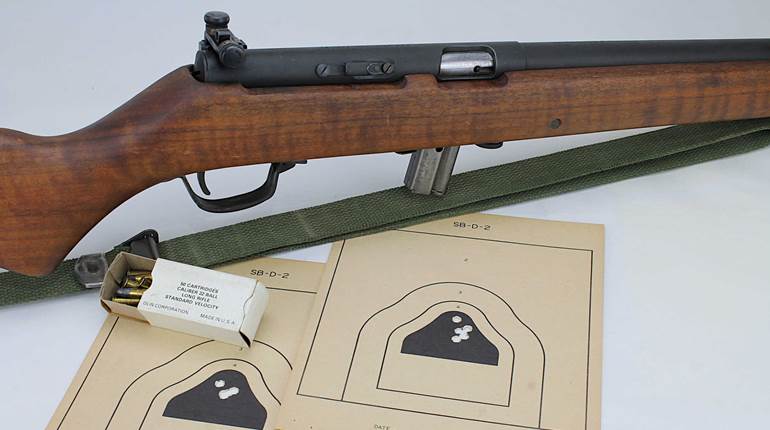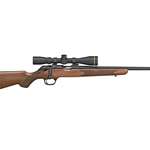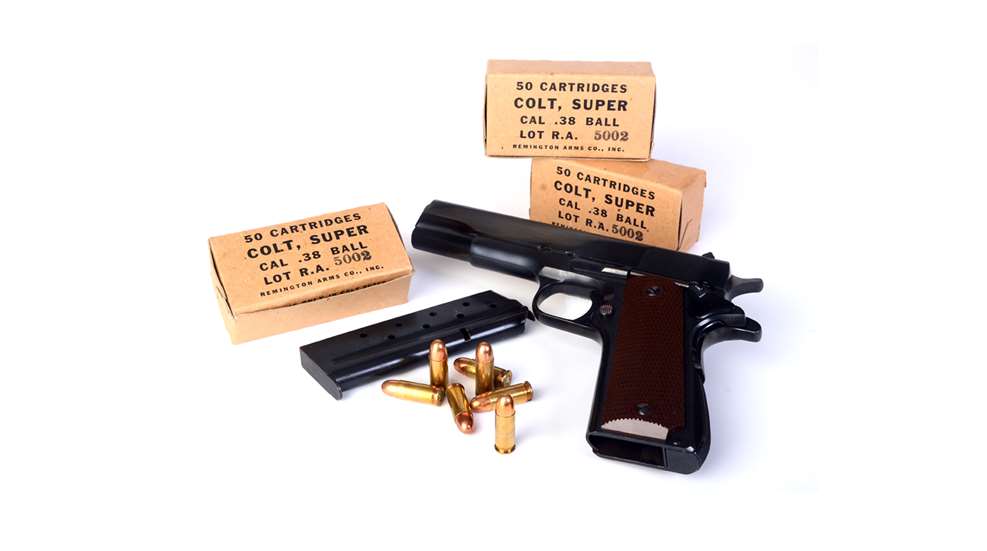
Spy movies captured my imagination in 1962 when my parents took me to see the James Bond classic “Dr. No” when I was 9 years old. More focused on the firearms than on the “Bond Girl” (my apologies to Ursula Andress), I was unaware then that the future destined me to cross paths with many real-world spies, and that through those associations I would acquire an amazing collection of firearms used during their clandestine work. One firearm in my collection is possibly the rarest of Colt variants, one as far as I know has never been featured in print or even photographed before.
Before getting to the details of the pistol itself, it's important for me to explain a bit of background. My introduction to firearms began in the summer of 1959 in rural Southampton County, Va., before I started school. Under my father’s tutelage, beginning with the gift of his Marlin Model 88 semi-automatic .22-cal. rifle, he instilled in me the strict protocols of proper use and safe handling. He was a gifted and ambidextrous golf professional from the days of the Great Depression and often supplemented our table fare with his expert hunting skills and considerable fishing prowess. We moved to Norfolk in 1961 after his new appointment as PGA golf professional of the U.S. Navy’s prestigious Commissioned Officer’s Sewell’s Point Golf Course and Country Club on the Norfolk Naval Station. As my marksmanship skills grew, he introduced me to his newly found friends, military and civil service firearms instructors at the world’s largest naval installation. The year 1963 was when my firearms education began in earnest, and those experiences fanned the flames of a passion that has lasted through the present.
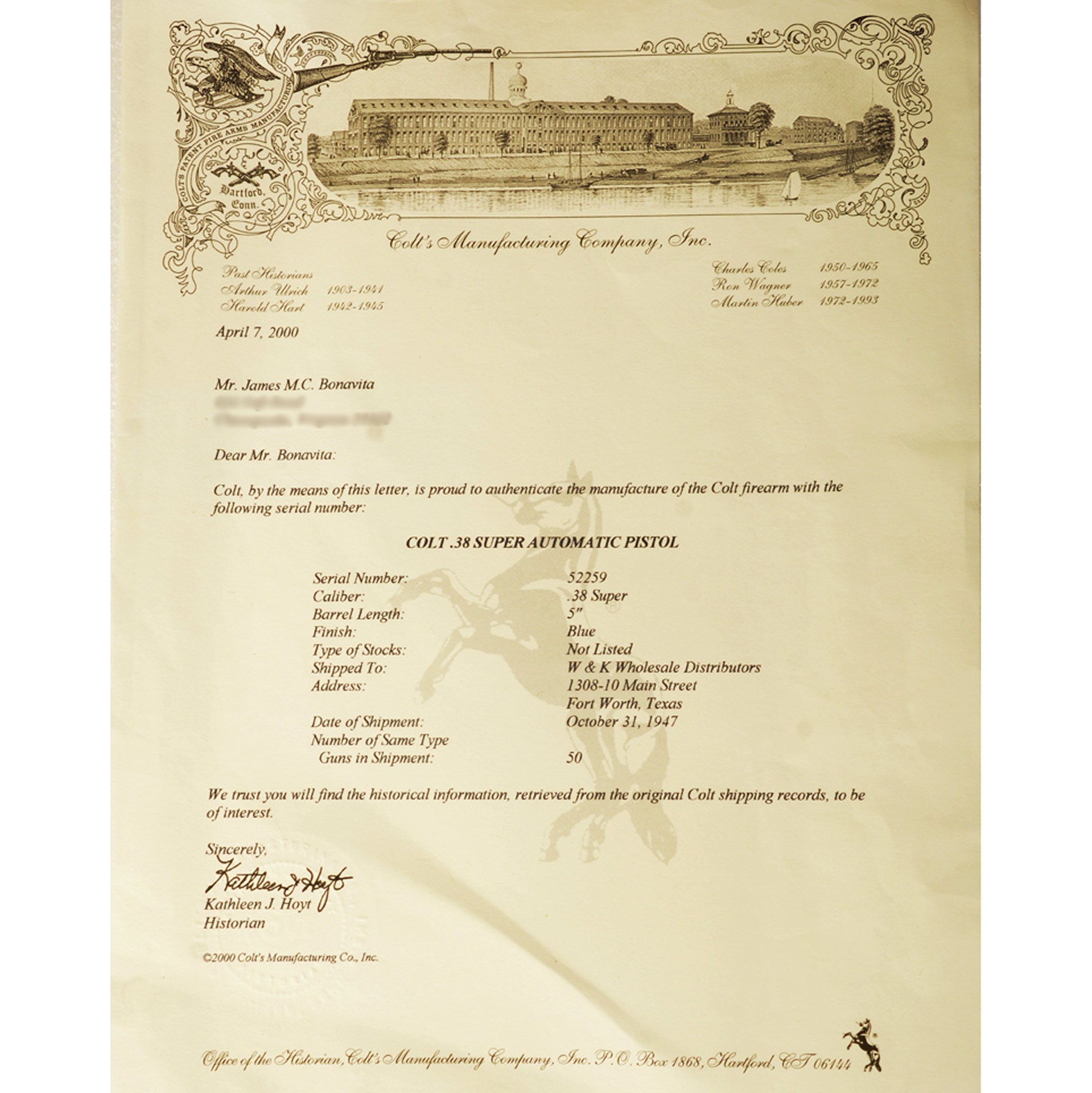 Colt factory letter of authenticity, dated April 7, 2000, documenting the sterile Colt 1911 .38 Super Automatic pistol. “Colt, by means of this letter, is proud to authenticate the manufacture of the firearm with the following serial number: Colt .38 Super Automatic Pistol, serial number 52259, blue(d) with a 5” barrel, was one in a shipment of 50 such pistols shipped to W & K Wholesale Distributors, 1308-10 Main Street, Fort Worth, Texas on October 31, 1947.” From the author’s collection.
Colt factory letter of authenticity, dated April 7, 2000, documenting the sterile Colt 1911 .38 Super Automatic pistol. “Colt, by means of this letter, is proud to authenticate the manufacture of the firearm with the following serial number: Colt .38 Super Automatic Pistol, serial number 52259, blue(d) with a 5” barrel, was one in a shipment of 50 such pistols shipped to W & K Wholesale Distributors, 1308-10 Main Street, Fort Worth, Texas on October 31, 1947.” From the author’s collection.
Dad started dropping me off every weekend at the naval station’s World War II-era indoor pistol range and armory under the watchful eyes of the gunsmith/armorer there. A former military pistol champion, Ray Cervilla, spent countless hours instructing me, assisted by other experienced firearms instructors, many of whom were either current or former national champions, members of the U.S. Navy and U.S. Marine Corps Pistol and High-Power Rifle Teams.
Under their strict, professional instruction, I soon learned to disassemble, reassemble, clean and repair every firearm that had been in the U.S. inventory from World War I through the mid-1960s, everything from lowly .38 Spl. revolvers up through and including .50-cal. M2 (“Ma Deuce”) machine guns. I was occasionally at the right time and place to examine and shoot exotic firearms shipped stateside from overseas conflicts for testing and evaluation, even experiencing such strange foreign arms as new “liberated” Soviet AK-47 and AKM rifles, largely unknown to the public or the media for years to come.
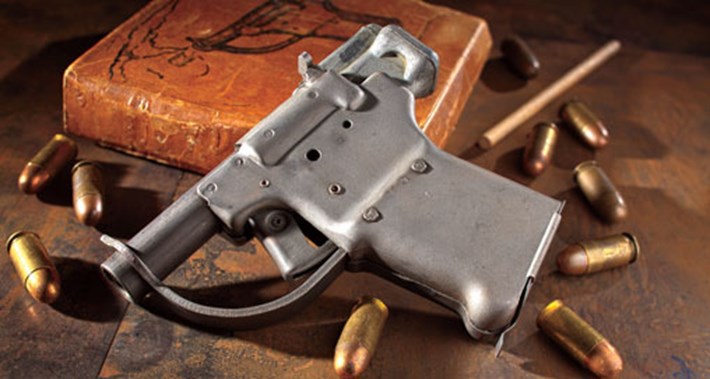 Perhaps no other handgun in U.S. history has been burdened with as many misconceptions about its post-production history as the “Liberator.” Conceived by the U.S. Joint Psychological Warfare Committee in early 1942 without any input from the armed services, production of 1 million Liberators was approved by Gen. Eisenhower and others.
Perhaps no other handgun in U.S. history has been burdened with as many misconceptions about its post-production history as the “Liberator.” Conceived by the U.S. Joint Psychological Warfare Committee in early 1942 without any input from the armed services, production of 1 million Liberators was approved by Gen. Eisenhower and others.
But what about those “spy guns” with which I was enamored? My instructors were all active-duty or former military, now civil service personnel, all of whom had seen combat in World War II and/or Korea and some of whom were rumored to have had experience with wartime intelligence agencies such as the Office of Naval Intelligence (ONI), and the Office of Strategic Services (OSS). President Truman officially terminated the OSS Sept. 20, 1945, with Executive Order 9621, but created the Central Intelligence Group (CIG), precursor to the CIA, on Jan. 22, 1946.
Then, with further reorganization and passing of the National Security Act of 1947, he finalized the current Central Intelligence Agency (CIA), a civilian group that assumed some of the former functions of the military, wartime OSS and more. My adolescent mind, already crammed with images of covert spies and their guns, nearly exploded as I listened to these men whispering about the various clandestine arms utilized by shadowy government agents and agencies. Small arms issued during wartime are generally marked similarly, or identically to their commercial counterparts, but occasionally, “sterile” or “sanitized” versions, devoid of any indication of manufacturer or country of origin, although usually retaining a serial number, are often created for limited, clandestine purposes. I remember being told of two such World War II guns, both of which are fortunately well-documented today.
The Welrod was a bolt-action, multi-shot, suppressed handgun designed and used by the British SOE (Special Operations Executive), and in smaller numbers by our own OSS. Intended for assassination of high-value German targets and the silent removal of sentries, it was initially issued in 7.65 mm (.32 ACP), but later modified to 9x19 mm Luger because the anemic .32 ACP proved to be inadequate. In all, about 14,000 were manufactured in both calibers combined. Today, a somewhat modernized reproduction is available B&T Station SIX-9 for those qualified purchasers wishing to own one.
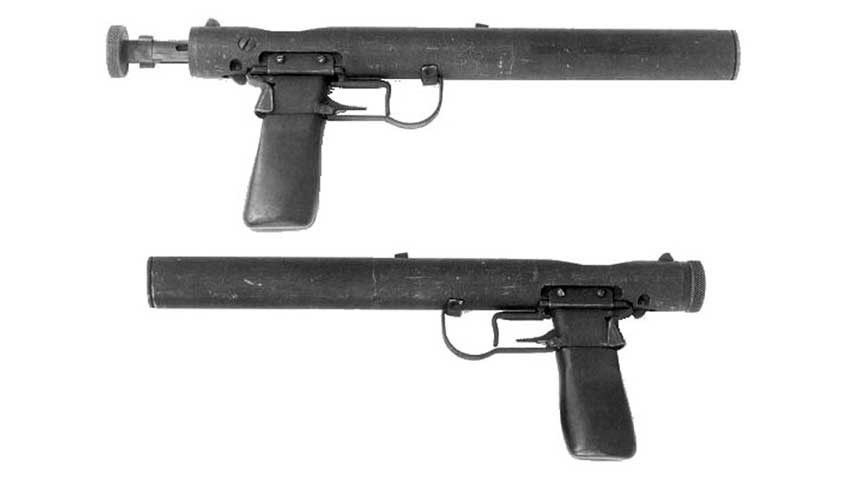 Views of the left and right side of the Welrod Mk I. Note that the striker is cocked in the top image.
Views of the left and right side of the Welrod Mk I. Note that the striker is cocked in the top image.
The FP-45 was a sterile, limited-purpose handgun manufactured by the Guide Lamp Division of General Motors, a very cheaply made, pressed-steel pistol manufactured for an incredible $2.10 per unit. A manually loaded and cocked single-shot, striker-fired pistol in .45 ACP, it was better known by its common name, the “Liberator.” Designed to be drop-shipped to resistance fighters behind enemy lines, it was meant to be used to overcome a better-armed enemy soldier who could then be liberated of his own, superior firearm(s). Neatly packaged in a small cardboard box, it came equipped with 10 rounds of FMJ ammunition (five of which were stored in a compartment in its grip), a wooden dowel to be used as a crude empty case ejector and a cartoon-illustrated instruction sheet.
Approximately 1 million of these unique pistols were produced during the summer of 1942, but only a few thousand were ever distributed because generals decided it was more important to drop bombs on the enemy than supply FP-45s to the resistance forces. The remaining pistols were destroyed before the war’s end, ensuring both its rarity and instant appeal to serious military collectors. A fairly accurate FP-45 reproduction, reminiscent of the original, has been produced by Vintage Ordnance Company, LLC, and can occasionally be encountered today.
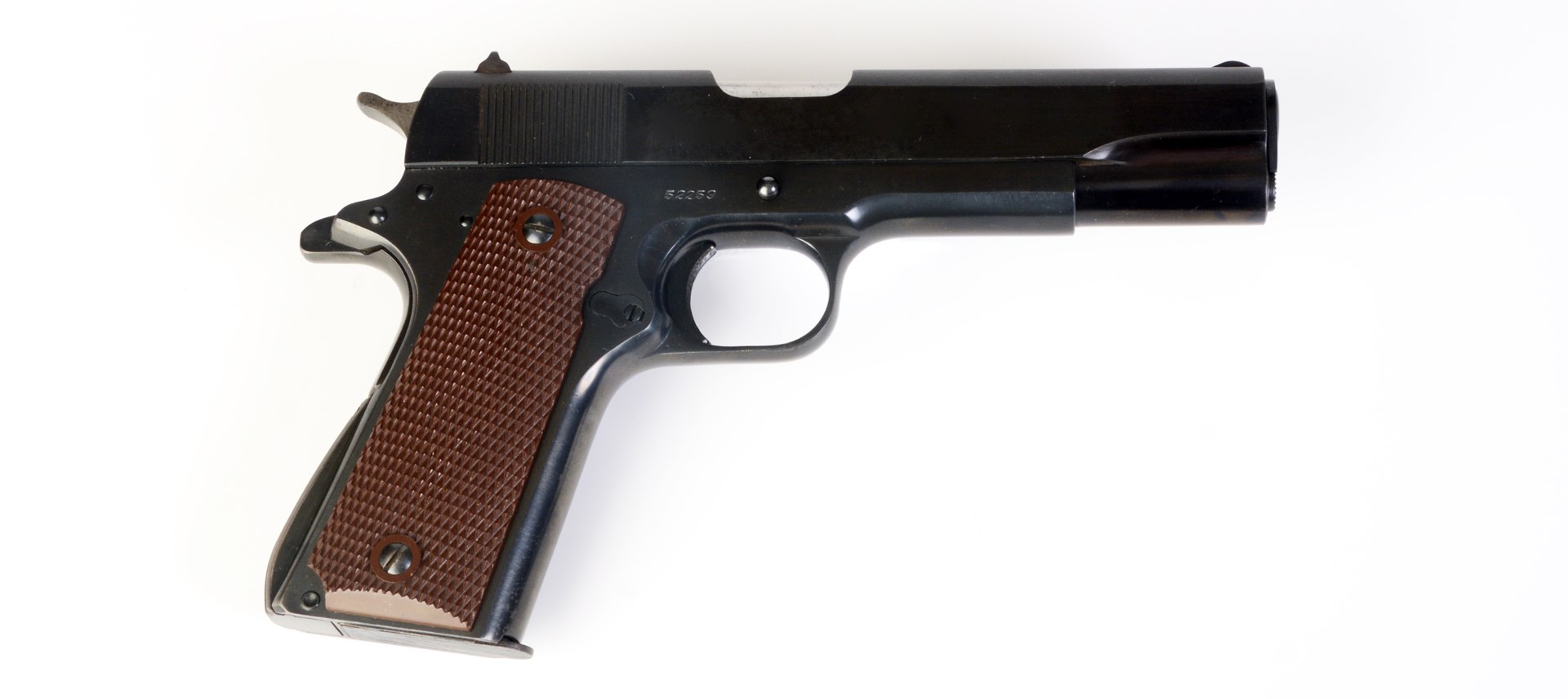 This ultra-rare Colt “sterile” Colt 1911 .38 Super Automatic, sans any roll marks other than the serial number, was confirmed by the Colt factory as having been manufactured in October 1947 and shipped from the factory on Oct. 31, 1947, to a firearm distributor, at which point the shipment disappeared. It has put to rest, at least for the author, a lifetime of speculation concerning its very existence, and but its discovery has spawned speculation and controversy. From the author’s collection.
This ultra-rare Colt “sterile” Colt 1911 .38 Super Automatic, sans any roll marks other than the serial number, was confirmed by the Colt factory as having been manufactured in October 1947 and shipped from the factory on Oct. 31, 1947, to a firearm distributor, at which point the shipment disappeared. It has put to rest, at least for the author, a lifetime of speculation concerning its very existence, and but its discovery has spawned speculation and controversy. From the author’s collection.
A third, less well-known, but also well-documented World War II OSS “spy gun” was the Colt M1911 pistol chambered in .38 Super. Manufactured in late 1945 utilizing the pistol cartridge developed in the 1920s, it was officially referred to as the “Super .38” through the mid-1950s. A semi-rimmed cartridge that was basically a higher-pressured variant of the .38 Automatic cartridge, it afforded velocities over 1,200 feet per second when utilizing a 130-grain FMJ projectile and was the choice of Depression-era Treasury and FBI agents due to its ability to penetrate the doors and radiators of cars driven by gangsters and rumrunners of the day. This new high performer was easily adapted to the M1911 platform, familiar to military and civilian personnel alike. Speculation is the OSS may have preferred their M1911s in this caliber versus the .45 ACP because wounds from its 0.356"-diameter bullets mimicked those of the 9 mm Parabellum, already in widespread use in the European theater.
It is well-documented that the OSS contracted with Colt to produce 400 of these rare pistols in .38 Super late in the war, 24 of which were shipped to Remington UMC in June 1945, for the testing of the company's .38 Super ammunition. Remington UMC produced about 2 million rounds of it in lots numbered #5001 and #5002, although several sources cite there was a third lot, numbered #5003. The remaining 376 pistols of the production run were shipped to the OSS’s famous Fowler Building in Rosslyn, Va., in July 1945. But the war ended on Aug. 14, 1945, and since the OSS was dissolved on Oct. 1, 1945, it isn’t likely any of them were issued before the Armistice.
Some were said to have been sold to military officers, and a number were shipped to post-war Europe (mainly Turkey, Spain and Belgium), but there is evidence that some may also have been sent to the newly formed CIA and state department in 1947. All OSS military M1911 .38 Supers had a unique mixture of features including brown plastic grip panels, grooved slide stops and mainspring housings, early stamped military triggers and the new, innovative internal Swartz safeties. The frames and slides, which were roll-marked nearly identically to those pistols commercially available to the public and had serial numbers that randomly fell between 32000-37835. Missing, however were the usual military inspection and “US Property” marks. According to advanced Colt collectors, only about 35 or so of the original 400 have surfaced in the United States post-war, with only about a dozen of those remaining in their issued condition with their original finish.
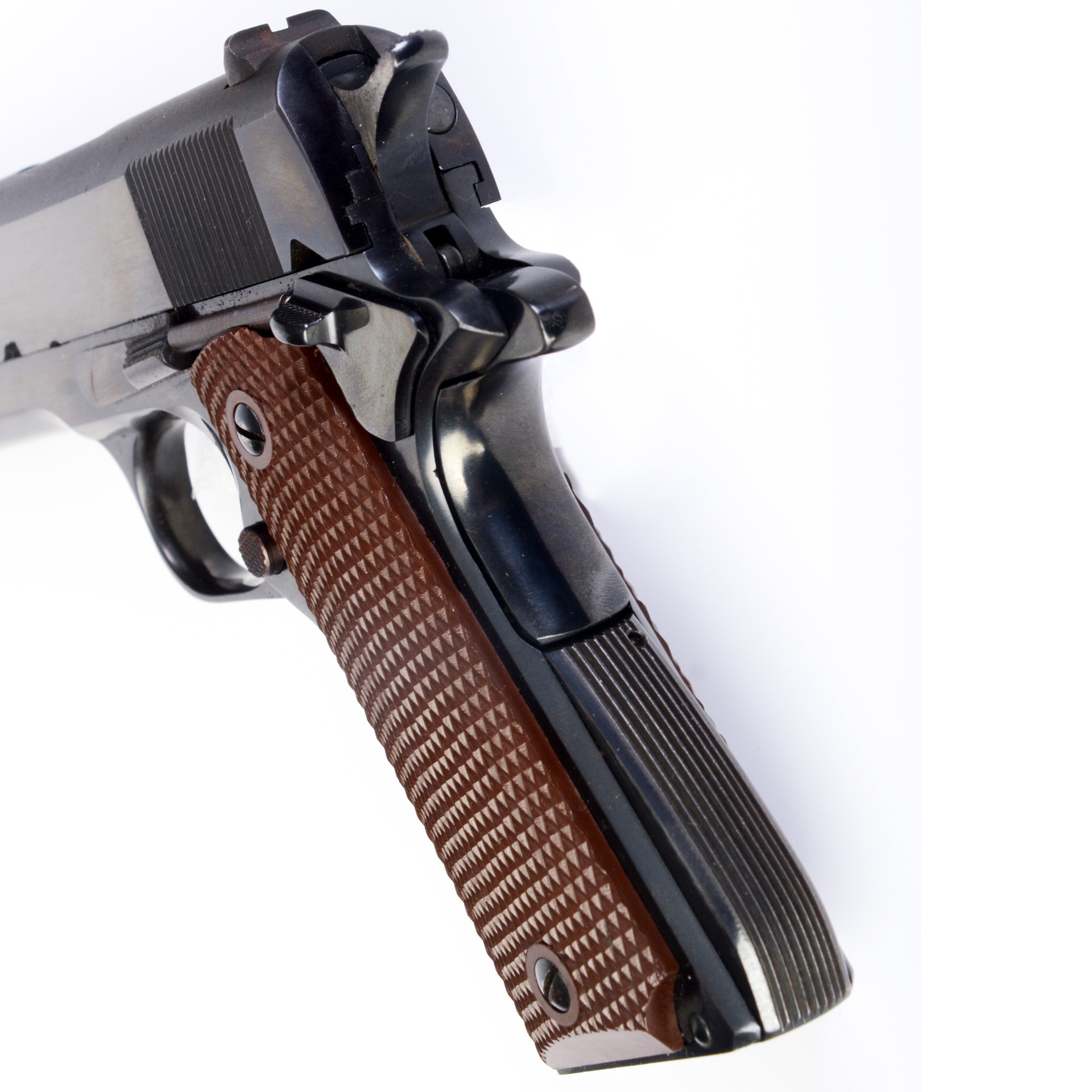
I spent decades pondering whether any rumored, “sterile” versions of the already-rare OSS .38 Supers were ever really produced and spent the past 27 years searching for any documentation of them. Why would such a specific, limited-purpose and ultra-rare unmarked pistol be created? The answer is for “plausible deniability.” It has always puzzled me why domestic spy agencies would go to such great lengths to produce sterilized or sanitized arms for clandestine use when the inevitable encounter of a completely unmarked, obviously American firearm in a conflict zone virtually screams “CIA!” I’ve always thought it smarter to utilize captured or covertly acquired standard issued foreign firearms for such missions, as did our Navy SEAL and Army Special Forces teams in Vietnam. These are far more easily denied, plausibly, than sterile or sanitized small arms, not to mention much easier and cheaper to acquire and resupply.
It is now known there were several top-secret post-war programs involving the clandestine emigration of Nazi scientists, engineers and even high-ranking officers in hiding south of the equator being brought into the United States and at least two other allied countries for the purposes of acceleration and expansion of scientific programs and securing successful experiments and advances already documented in Hitler’s secret laboratories, the most famous being “Operation Paperclip,” once our most top-secret program.
Originating as an idea within the Pentagon’s joint chiefs, known as the Joint Intelligence Objectives Agency (JIOA), it ignited a firestorm of controversy between the more conservative generals, who opposed the very idea of the integration, and subsequent “whitewashing,” of former Nazi war criminals into our own scientific community, an act they believed akin to “making a deal with the devil,” and the more progressive generals who were interested in keeping ahead of the Soviets technically, tactically and logistically at any cost.
Not surprisingly, the Soviets had a nearly identical, albeit larger program, “Operation Osoaviakhim,” implemented nearly a year earlier than our own. Great Britain’s “Operation Surgeon” was also similar, albeit a much smaller program. Hollywood has acknowledged and exploited these secret, controversial operations in several 1970s-era films of surviving Nazi war criminals; “The Boys from Brazil,” “The Odessa File” and “Marathon Man” are three that immediately come to mind.
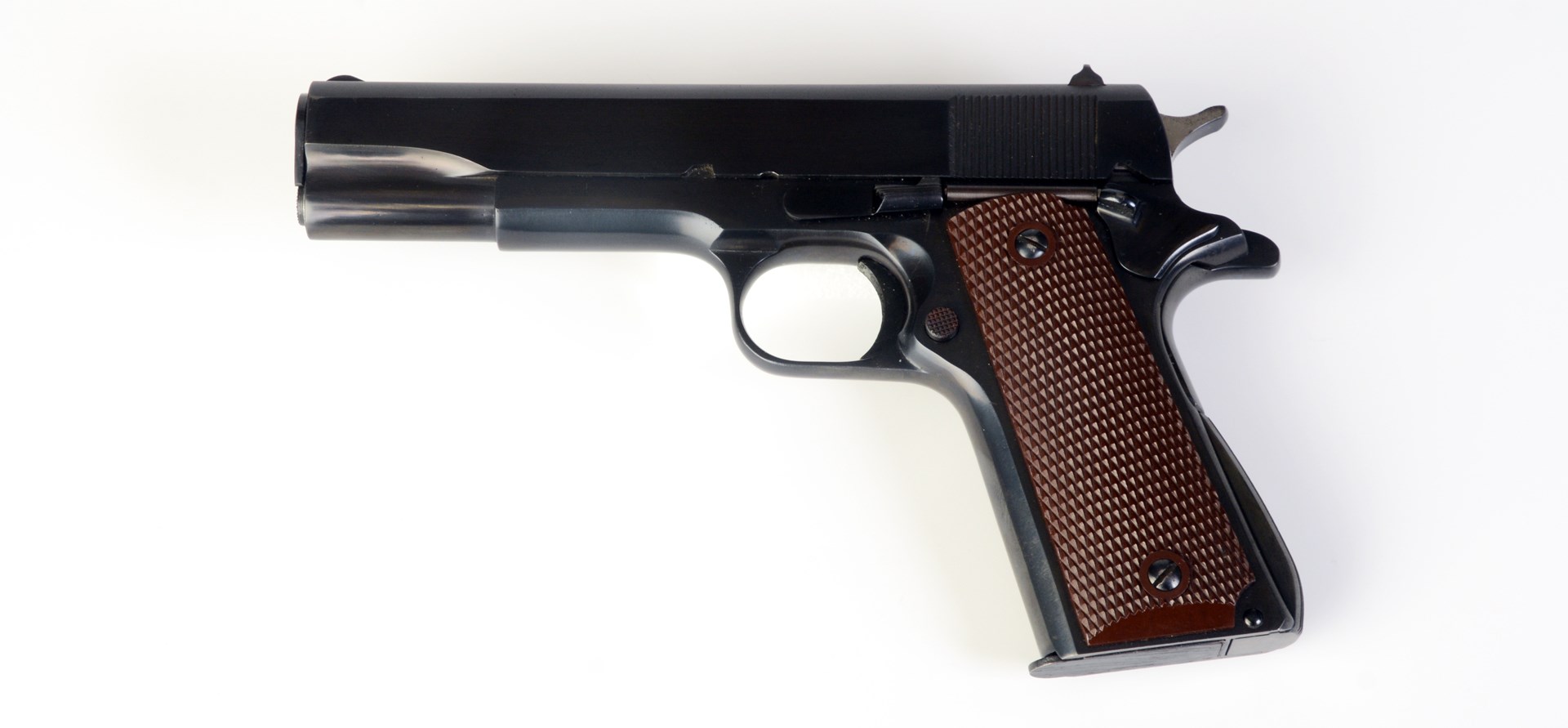
Rumors of “untraceable” pistols being produced for the protection of our clandestine agents and former Nazis awaiting emigration to the U.S. is fascinating but has been based mostly on speculation due to the lack of documentation. With all the mystery and drama of those 1970s Hollywood movies, discussions of such unicorns occasionally surfaced among serious fellow firearms and militaria collectors over the decades, especially when the subject of rare military firearms arose. All of this speculation jelled for me on the evening of Feb. 13, 1996.
I was invited to a fellow collector’s house for what I assumed was going to be another friendly evening of trading guns and accoutrements as had occurred between us for more than 20 years. My elderly German friend, by that time into his late 70s and in declining health, seemed in an unusually melancholy mood. I was ushered into his sitting room, and after some small talk, he shuffled over to a coat closet, turned to face me and stated, “I know what I’m getting ready to give you, you’ll keep for the rest of your life. If I leave it to my children, they’ll sell it for beer money.”
He then opened the closet door and dragged out an old olive-drab military trunk. Flinging back the lid, he lifted out something carefully wrapped in an old, oily towel: a blued M1911. After a momentary pause, he stated, “You can only have this if you can tell me what it is!” He explained that no one he’d ever showed it to had properly identified it, and he wondered if I might just be able to. As I accepted it from his trembling hands, it first appeared to be just another “minty” example of a commercial post-war 1911 like I had seen before. However, on closer inspection I was stunned that, but for the visible five-digit serial number on the right side of the frame, there were no other visible markings of any kind on it. As my heartbeat increased, I examined the muzzle and noted the bore was noticeably smaller than .45 caliber.
Hesitating only a moment, I looked up with a confident and youthful grin and stated, “I know what it is!” I then briefly recounted my boyhood experiences at that Navy range so long ago, and the discussions of sterile M1911 .38 Super pistols supposedly “made by Colt for clandestine use by the CIA.” My friend simply smiled and said, “It’s yours!” While staring down at a pistol many more knowledgeable and experienced people than I insisted did not exist, my elderly German friend simply advised “it had been provided to him” on Nov. 30, 1947, while he was in Argentina. Few other specific details were offered during the remainder of that very pleasant and very memorable evening.
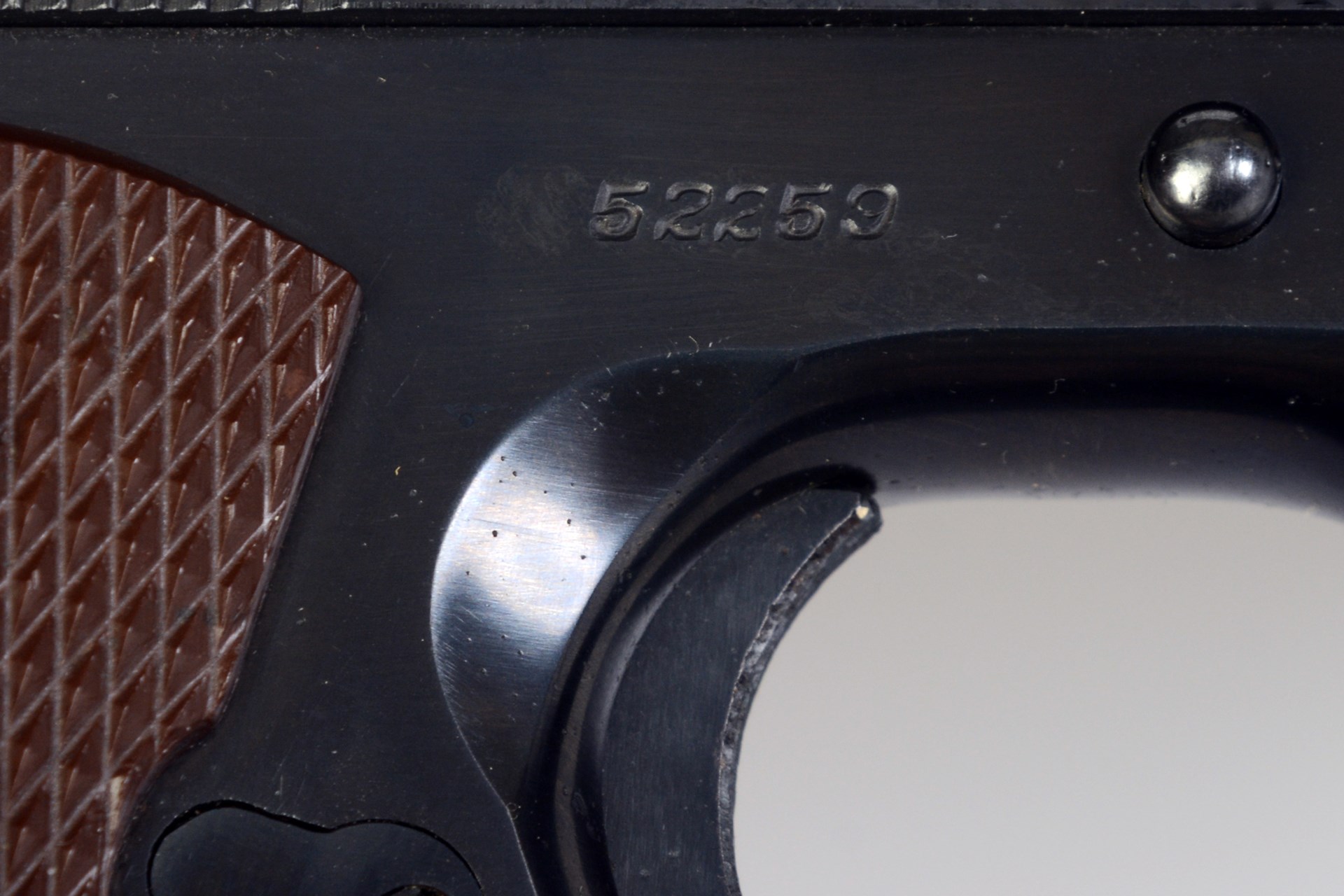
Driving home in a fog with my newly corralled unicorn laying on the seat next to me, I fully expected to learn much about my new acquisition. However, in the ensuing years, even in the age of Google, this has proven frustrating, as details have remained elusive. Over the years, I’ve been unable to locate a single legitimate photograph or a specific reference to this specific Colt pistol. Further, no one with direct knowledge or experience with one like it could be found. Even curators at several military museums and numerous serious Colt collectors and military historians could produce little other than the rumors reminiscent of my youth. In one last, desperate attempt to learn anything about it, and unable to find an affordable copy of the definitive Colt’s Super .38: The Production History from 1929 to 1971, I wrote directly to the author, Douglas G. Sheldon. This began a two year-long exchange of letters, documents and photos with the author.
Intrigued and claiming he’d never actually handled one, he admitted to hearing rumors of their existence. Requested photographs were sent that intrigued him, and he advised I had indeed found quite a prize: “An uncommon, great early post-war pistol, especially being in pristine condition,” he stated. Had I requested a letter of authenticity from Colt, he asked? I answered in the affirmative and promised him a copy once received. In the meantime, he instructed me to look for a tiny, almost microscopic telltale letter “H” (signifying “Hartford”) in a well-hidden, internal location he revealed to me. Yes, there it was!
Was the bluing on the top of the slide a “bead-blasted, blued finish (to prevent glare)? Yes, again! I examined the slide stop, thumb safety and other small parts under magnification and noted that minute striations (fine tool marks) precisely matched those of other contemporary Colt M1911s. Compared it to wartime OSS .38 Supers, there are a number of similarities and a couple of differences. Although it has the same grooved slide stop, mainspring housing, and wartime M1911A1 brown plastic grip panels, it has a later, milled, grooved trigger, and it is devoid of the Swartz safety, normal for post-1945 Colt M1911s. Like the pistol, the Colt factory magazine is also completely sterile. Close examination convinced me the pistol was a definite Colt, in original condition and with its original blued finish. Colt’s letter of authenticity (LOA) soon arrived and removed all doubt.
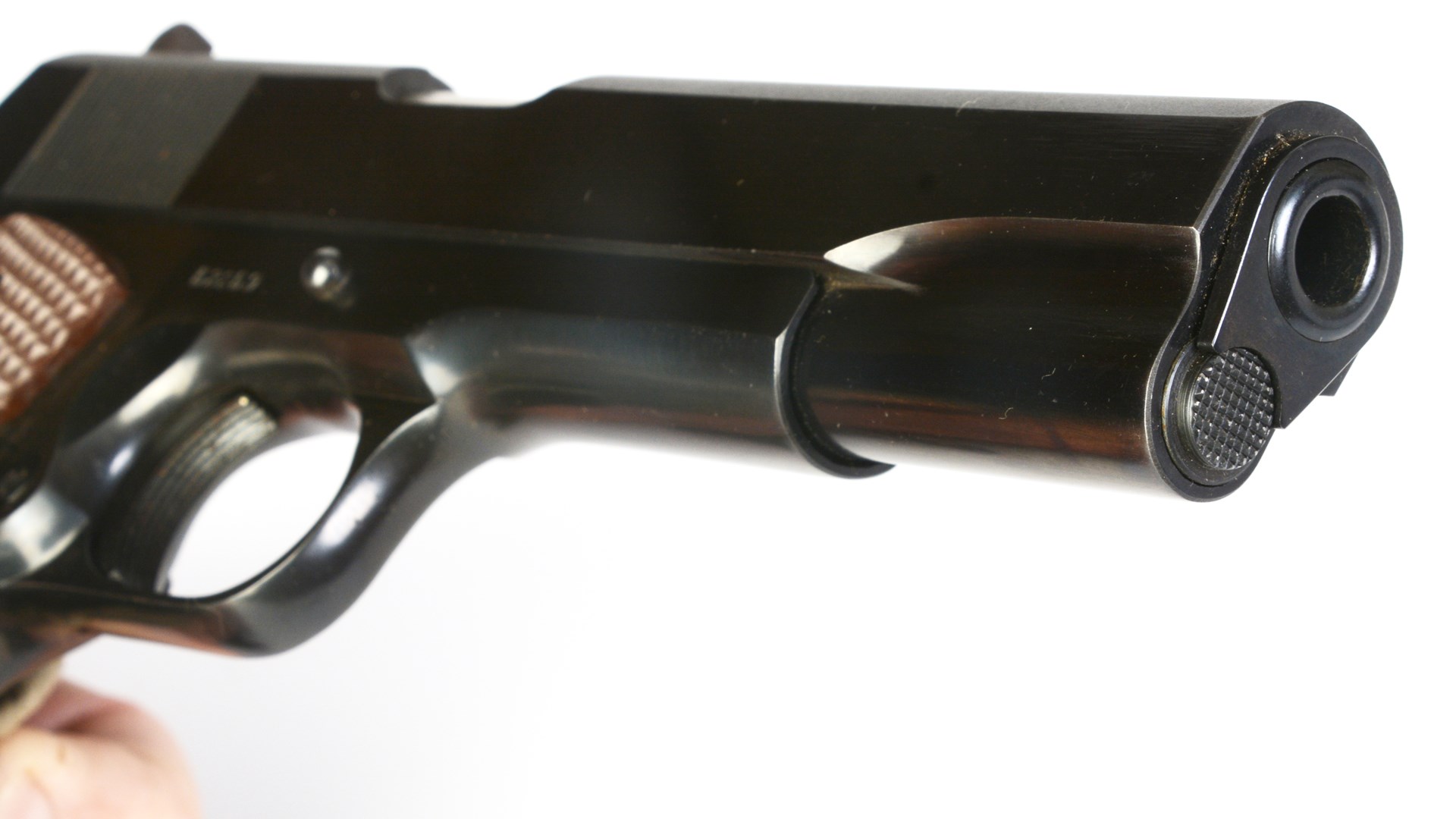
The LOA, shown in the accompanying photograph, is dated April 7, 2000, and states, “Colt, by means of this letter, is proud to authenticate the manufacture of the firearm with the following serial number: Colt .38 Super Automatic Pistol, serial number 52259, blue(d) with a 5” barrel, was one in a shipment of 50 such pistols shipped to W&K Wholesale Distributors, 1308-10 Main Street, Fort Worth, Texas on October 31, 1947.” (The humor of that date has not escaped me.) Interestingly, no Colt production order number is provided.
A former DEA and NCIS agent friend, himself the son of a retired (and now deceased) 30-year CIA field operative said his father advised him W&K Wholesale Distributors occasionally handled firearms shipments for “individual government agents and sometimes government agencies” during that Cold War. Mr. Sheldon, himself familiar with W&K Wholesale Distributors, said he had never heard of this before, and I fully admit to being unable to independently verify it for myself, however, what other reasonable explanation could exist whereby a commercial firearms distributor would receive, much less request, a shipment of 50 sterile military Colt handguns, especially one conveniently missing a Colt factory order number? Unfortunately, anyone old enough to have personal, direct knowledge or experience with issuance of such unique, ultra-rare pistols today has most likely passed on. And with the absence of further documentation, it will probably forever remain a mystery.
In summation, it is thoroughly documented that 400 very rare and unique Colt M1911 .38 Super Automatics pistols were manufactured for the OSS in 1945, and of that original 400, less than 40 surviving examples have purportedly surfaced. Per the Colt factory letter of authenticity in my possession, at least “a shipment of 50 such” similar, but sterile, Colt M1911 .38 Super Automatic pistols were made in late 1947, quite possibly the only 50 such pistols ever manufactured by Colt.
With the absence of further documentation, and the end-user(s) of such pistols remaining a mystery, anecdotal indications are that this extremely rare pistol was created for a very limited, highly clandestine purpose. Unlike the Welrod, the FP-45, or even the wartime OSS .38 Super, it is still basically an unknown entity. Unless another of the remaining 49 has surfaced in the recent years without my knowledge, the reader is herein afforded a first glimpse of a real-life firearms “unicorn.”












